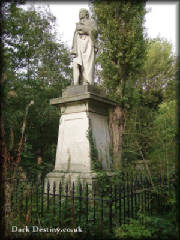|
Edward Hodges Baily RA FRS (March 10, 1788 - May 22, 1867) - (sometimes
misspelled Bailey) was an English sculptor who was born in Bristol. Some of his descendants still live in Bristol today and
a sculpture of 'Eve at the Fountain' can be found in the Bristol City Museum and Art Gallery.

His father, who was a celebrated carver of figureheads for ships, destined him for a commercial life, but
even at school the boy showed his natural taste and talents by producing numerous wax models and busts of his schoolfellows,
and afterwards, when placed in a mercantile house, still carried on his favourite employment. Two Homeric studies, executed
for a friend, were shown to John Flaxman, who bestowed on them such high commendation that in 1807 Baily came to London and
placed himself as a pupil under the great sculptor. In 1809 he entered the Royal Academy Schools.
In 1811 he gained the Royal Academy gold medal for a model of Hercules restoring Alcestis to Admetus, and soon after
exhibited Apollo discharging his Arrows against the Greeks and Hercules casting Lichas into the Sea. He was elected ARA in
1817 and RA in 1821 when he exhibited one of his best pieces, Eve at the Fountain. He was entrusted with the carving of the
bas-reliefs on the south side of the Marble Arch in Hyde Park, and executed numerous busts and statues of public figures,
including the prominent, well-known statue of Nelson, at the top of Nelson's Column, in Trafalgar Square. In 1857, the year
of his retirement from the Royal Academy, he also designed a Turner Gold Medal for Landscape Painting.

Baily's election as a fellow of the Royal Society (FRS) came in 1842. Amongst his pupils was William Theed
(1804-1891), a leading Victorian sculptor who produced a number of portrait busts and the large group sculpture ‘’Africa’’
for the Albert Memorial in Kensington Gardens. Among Baily's assistants were Musgrave Watson (1804-1847) and Joseph Durham
ARA (1814-1877).
Financial insecurity was a recurring theme in his life. He was first declared bankrupt in 1831, and again
in 1838. On the first occasion questions were asked in Parliament on his behalf because his financial distress had resulted
from delays in receiving payment for sculptures at Buckingham Palace. Fortunately his appeals to the Royal Academy for financial
assistance, were successful in the 1830s, as again in the 1860s, when they provided him with a pension of £200 a year as an
honorary retired RA.
Amongst Baily's many busts and statues of scientific, religious and literary figures (mostly from the Victorian
period but some from earlier periods) are following :
Charles James Fox & Lord Mansfield - St.Stephen's Hall, Westminster, London
Lord Byron - Harrow School; and Newstead Abbey, Nottinghamshire
Michael Faraday - University Museum, Oxford
Dr Isaac Watts - Dr Watts' Walk, Abney Park Cemetery, Stoke Newington, London
Sir Robert Peel - Market Place, Bury
Horatio, Viscount Nelson - on Railton's column, Trafalgar Square
Philip John Miles - Holy Trinity, Abbots Leigh
Richard Owen - Royal College of Surgeons
Sir John Herschel - St. John's College, Cambridge
Thomas Bewick - Literary & Philosophical Society, Newcastle upon Tyne
Sir James Knott - as above
George O'Brien Wyndham, 3rd Earl of Egremont - St.Mary's, Petworth, Sussex
Charles, 2nd Earl Grey - Grey Street, Newcastle upon Tyne
Eve at the Fountain - Art Gallery, Cambridge
Eve at the Fountain - Bristol City Museum and Art Gallery
Governor Richard Bourke - State Library of New South Wales, Sydney
Athena - The Athenaeum Club, Waterloo Place, Pall Mall, London
Sir Thomas Picton - Carmarthen, Wales
Chief Justice Tindal - Tindal Square, Chelmsford, Essex
Sir Charles Metcalfe - Kingston, Jamaica
Thomas Fleming - Manchester Cathedral
Justice - Old Council House, Bristol
Baily died at 99 Devonshire Road, Holloway on 22 May 1867 and is buried in London's Highgate Cemetery.
|

